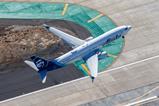In a major milestone for electric aircraft developer Beta Technologies, the start-up has successfully transitioned a full-scale prototype of the electric vertical take-off and landing (eVTOL) variant of its Alia aircraft from hover to wing-borne forward flight – and back to hover.
The Vermont-based company disclosed on 23 April that it had achieved the significant technical feat during a 17 April flight piloted by test pilot Nate Moyer at New York’s Plattsburgh International airport.
The eVTOL took off vertically using its four lifting propellers and then slowly transitioned to forward flight using its aft-positioned pusher propeller, with Moyer then disengaging the lift propellers – effectively turning the Alia prototype into a fixed-wing aircraft.
The aircraft transitioned back to hover and landed vertically after Moyer re-engaged the vertical propellers.
”We’ve been progressing toward this technical milestone for a while,” Beta says. ”It’s a new flight regime, and we fly all our missions with a pilot in the seat, so we approached it the best way we know how: by respecting physics. Like everything we do at Beta, we took a methodical, step-by-step approach.”

The successful transition flight seemingly counters recent speculation that Beta had chosen to focus development efforts on the electric conventional take-off and landing (eCTOL) variant of Alia, which it intends to certificate before the eVTOL.
Sergio Cecutta of SMG Consulting recently told FlightGlobal that he believes criticism of the strategy is unwarranted. He believes that Beta’s plan to pursue first pursue certification of its eCTOL under the FAA’s Part 23 airworthiness standards for small aircraft is savvy.
”I give them plus points for the simple reason that there is extremely high commonality between the two platforms,” he says. “Their CTOL is a Part 23 airplane with a battery; nothing special. Once you’ve certified that under Part 23, you can take the majority of those documents and wrap them up under ‘powered lift’ and boom – you’ve got an eVTOL.”
Beta calls the test flight a step toward “getting this technology into the market and into the hands of our customers”.
“This runway independent aircraft will first be used by military, then cargo carriers, followed by passenger-carrying operators,” the start-up says. ”The simplicity significantly reduces maintenance and cost [and] increases reliability and safety, all while flying with zero emissions.”


























![[Photo] Korean Air K-UAM](https://d3lcr32v2pp4l1.cloudfront.net/Pictures/100x67/7/3/1/101731_photokoreanairkuam_478072.jpg)




